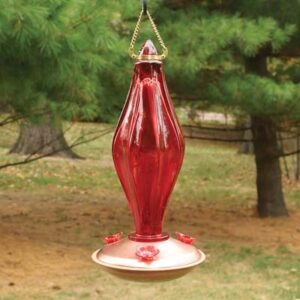A Hummingbird feeder seems like a good idea right? After all, millions of people enjoy watching these active little birds each year, but what if something goes wrong?
 Hummingbirds are notoriously finicky about their feeders. Pests, nectar going rancid and leaks in the filter can all cause a new birder to become frustrated and give up. Follow these simple troubleshooting tips instead and you’ll have colorful Hummingbirds in your yard just in time for Spring.
Hummingbirds are notoriously finicky about their feeders. Pests, nectar going rancid and leaks in the filter can all cause a new birder to become frustrated and give up. Follow these simple troubleshooting tips instead and you’ll have colorful Hummingbirds in your yard just in time for Spring.
If your Hummingbird Feeder attracts ants
The most common pest attracted to your feeder will be ants. The sugary nectar is irresistible to these common backyard pests. Luckily, combating an ant problem is fairly simple. Simply hang your feeder from an ant moat. Instead of adding water to your ant moat, use a sticky substance, like Vaseline which doesn’t require frequent refilling. Then, each time the nectar is changed in your feeder, you can use a toothpick to “reactivate” the ant moat. Problem solved!
What to do about bees in your feeder
After ants, bees and other airborne pests, are the next most common problem you’re likely to face. More challenging to deter, follow these three simple steps to keep them at bay:
- Clean the feeder thoroughly each time the nectar is changed. Residual nectar on the outside of the feeder will attract bees and other flying pests.
- Keep your feeder in the shade. Full sun is an easier place for nectar to spoil and is much more likely to attract bees and wasps.
- Paint yellow accents on your Hummingbird feeder with red nail polish. Bees are attracted to the color yellow. It is often used as an accent on feeders. By removing the alluring yellow color, bees are less reminded of flowers and more likely to stay away.
- If all else fails, carefully rub petroleum jelly around the nectar holes. Be extremely diligent in making sure the jelly doesn’t drip into the nectar. The slick surface will make it more difficult for bees, wasps and flies to land.
Dealing with nectar spoilage
The warmer the climate, the more often nectar must be changed. Otherwise, spoilage can cause birds to stop coming to your feeder. Spoiled nectar can also harm little Hummingbirds digestive system. Spoilage is easily avoided. Simply keep your bird feeder out of direct sunlight and change the nectar every 2-3 days.
To avoid wasting nectar, try to only place enough in the feeder to meet the needs of your Hummingbird population. If only a few Hummingbirds visit your yard, consider keeping the reservoir for your nectar only half full.
DIY fixes for leaky feeders
Many Hummingbird feeders will drip naturally. This isn’t a big problem unless bees or aesthetics are a concern. If this is the case in your backyard, use a saucer feeder instead and avoid the leakage problem.
By following these simple steps, you can ensure the Hummers you’re trying to attract always have a perfect place to feed.

